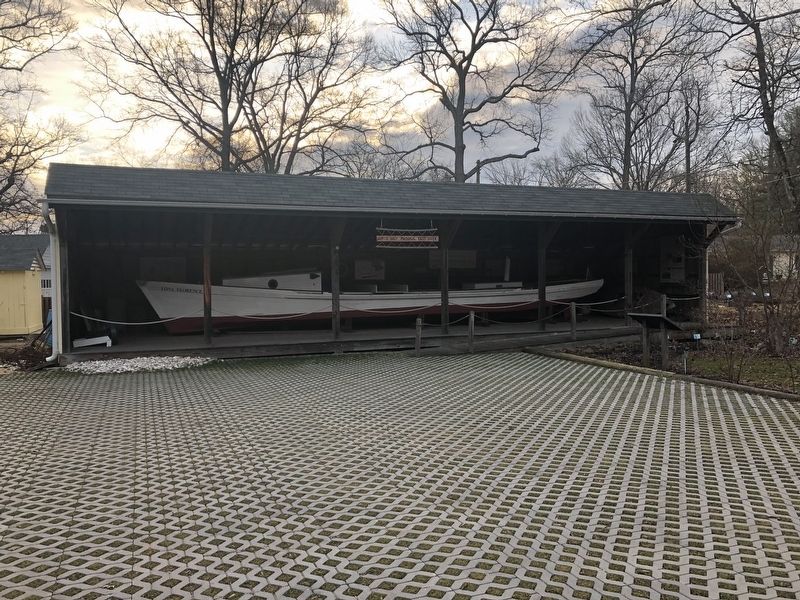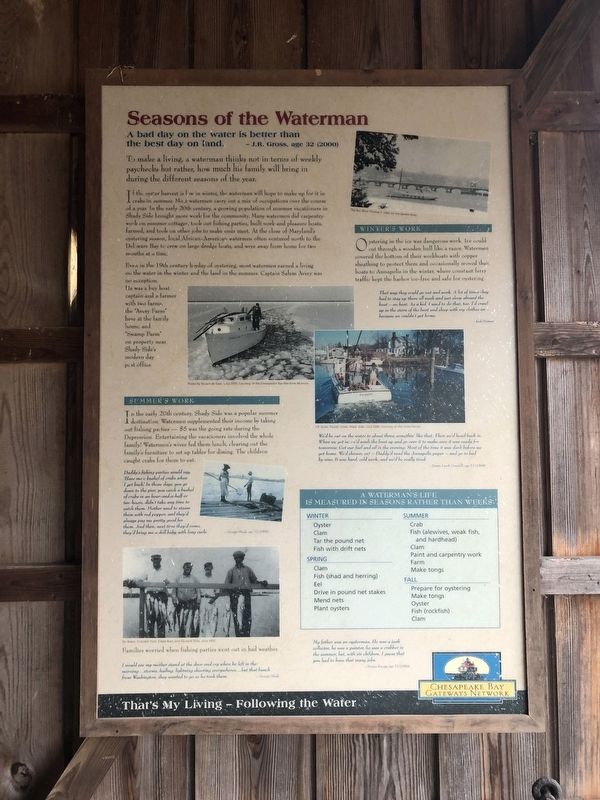Shady Side in Anne Arundel County, Maryland — The American Northeast (Mid-Atlantic)
Seasons of the Waterman
— J.R. Gross, age 32 (2000)
To make a living, a waterman thinks not in terms of weekly paychecks but rather, how much his family will bring in during the different seasons of the year.
If the oyster harvest is low in the winter, the waterman will hope to make up for it in crabs in summer. Most watermen carry out a mix of occupations over the course of a year. In the early 20th century, a growing population of summer vacationers in Shady Side brought more work for the community. Many watermen did carpentry work on summer cottages, took out fishing parties, built work and pleasure boats, farmed, and took on other jobs to make ends meet. At the close of oystering season, local African-American watermen often ventured north to the Delaware Bay to crew on large dredge boats, and were away from home for two months at a time.
Even in the 19th century heyday of oystering, most watermen earned a living on the water in the winter and the land in the summer. Captain Salem Avery was no exception. He was a buy boat captain and a farmer with two farms, the "Avery Farm" here at the family home, and "Swamp Farm" on property near Shady Side's modern day post office.
Summer's Work
In the early 20th century, Shady Side was a popular summer destination. Watermen supplemented their income by taking out fishing parties — $5 was the going rate during the Depression. Entertaining the vacationers involved the whole family! Watermen's wives fed them lunch, clearing out the family's furniture to set up tables for dining. The children caught crabs for them to eat.
Daddy's fishing parties would say, 'Have me a bushel of crabs when I get back.' In those days, you go down to the pier, you catch a bushel of crabs in an hour-and-a-half or two hours, didn't take any time to catch them. Mother used to steam them with red pepper, and they'd always pay me pretty good for them. And then, next time they'd come, they'd bring me a doll baby with long curls.
— George Mauk, age 72 (1991)
Families worried when fishing parties went out in bad weather.
I would see my mother stand at the door and cry when he left in the morning...storms, hailing, lightning shooting everywheres...but that bunch from Washington, they wanted to go so he took them.
— George Mauk
Winter's Work
Oystering in the ice was dangerous work. Ice could cut through a wooden hull like a razor. Watermen covered the bottom of their workboats with copper sheathing to protect them and occasionally moved their boats to Annapolis in the winter,

Photographed By Devry Becker Jones (CC0), February 16, 2019
2. The marker is part of this outdoor exhibit.
That way they could go out and work. A lot of times they had to stay up there all week and just sleep aboard the boat — no heat. As a kid, I used to do that too. I'd crawl up in the stern of the boat and sleep with my clothes on — because we couldn't get home.
— Jack Nieman
We'd be out on the water to about three, somethin' like that. Then we'd head back in. When we got in, we'd wash the boat up and go over it to make sure it was ready for tomorrow. Get our fuel and oil in the evening. Most of the time it was dark before we got home. We'd shower, eat — Daddy's read the Annapolis paper — and go to bed by nine. It was hard, cold work, and we'd be really tired.
— Jimmy Lerch Crandall, age 53 (1998)
Winter
Oyster
Clam
Tar the pound net
Fish with drift nets
Spring
Clam
Fish (shad and herring)
Eel
Drive in pound net stakes
Mend nets
Plant oysters
Summer
Crab
Fish (alewives, weak fish, and hardhead)
Clam
Paint and carpentry work
Farm
Make tongs
Fall
Prepare for oystering
Make tongs
Oyster
Fish (rockfish)
Clam
My father was an oysterman. He was a junk collector, he was a painter, he was a crabber in the summer, but, with six children, I guess that you had to have that many jobs.
— Emma Knopp, age 72 (1984)
That's My Living — Following the Water
Erected by Chesapeake Bay Gateways Network.
Topics. This historical marker is listed in these topic lists: African Americans • Industry & Commerce • Waterways & Vessels.
Location. 38° 50.956′ N, 76° 30.71′ W. Marker is in Shady Side, Maryland, in Anne Arundel County. Marker is on East West Shady Side Road west of Bast Avenue, on the right when traveling north. Touch for map. Marker is at or near this postal address: 1418 East West Shady Side Road, Shady Side MD 20764, United States of America. Touch for directions.
Other nearby markers. At least 8 other markers are within walking distance of this marker. Fishing (here, next to this marker); Crabbing (here, next to this marker); Oystering (here, next to this marker); Eels, Ducks, and Clams (here, next to this marker); The Edna Florence (a few steps from this marker); Transformation of the Avery House and over a Century of Expansion (a few steps from this marker); Going to Market (a few steps from this marker); Edna Florence (a few steps from this marker). Touch for a list and map of all markers in Shady Side.
Credits. This page was last revised on February 18, 2019. It was originally submitted on February 16, 2019, by Devry Becker Jones of Washington, District of Columbia. This page has been viewed 186 times since then and 12 times this year. Photos: 1, 2. submitted on February 16, 2019, by Devry Becker Jones of Washington, District of Columbia. • Bill Pfingsten was the editor who published this page.
